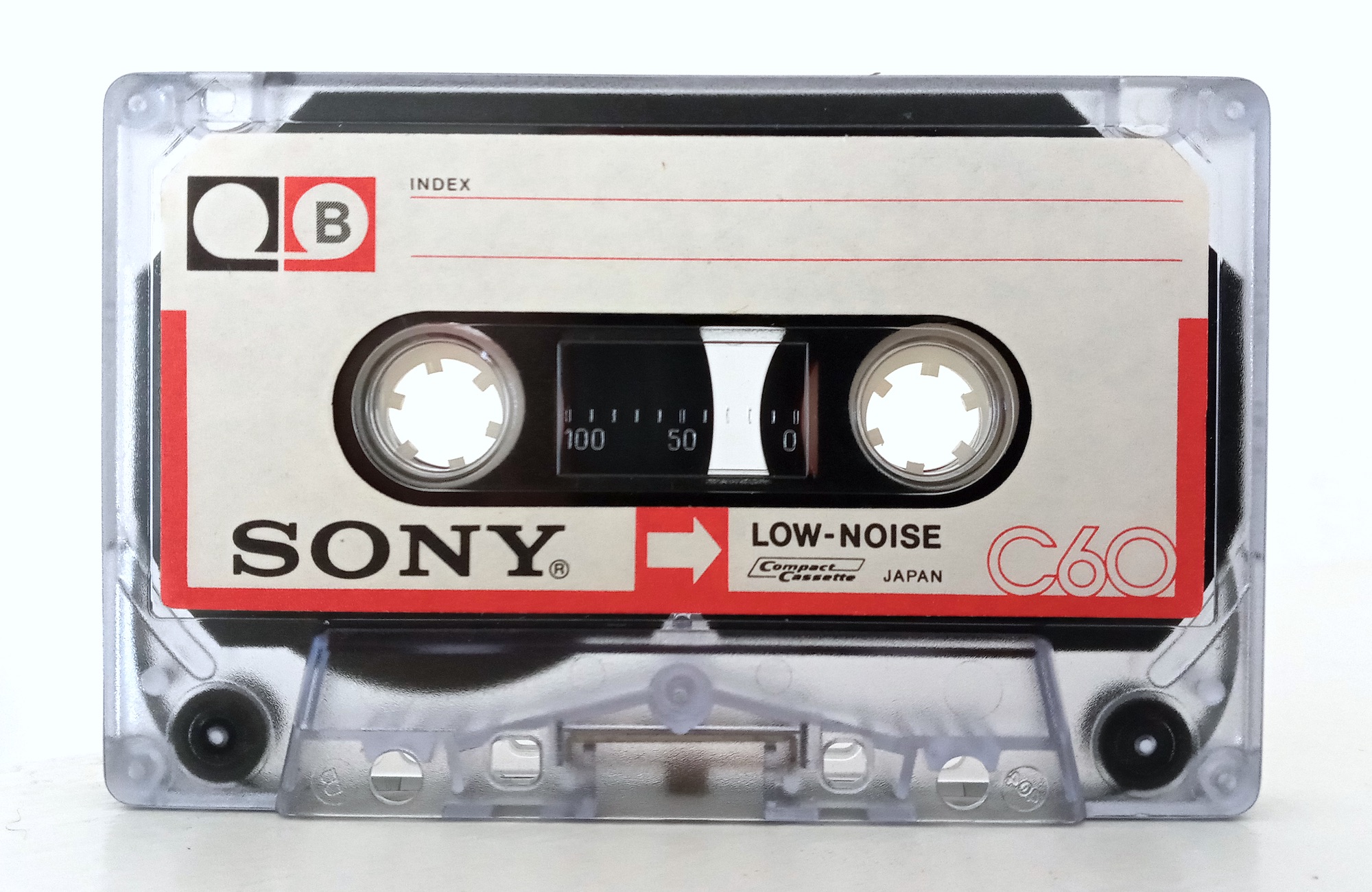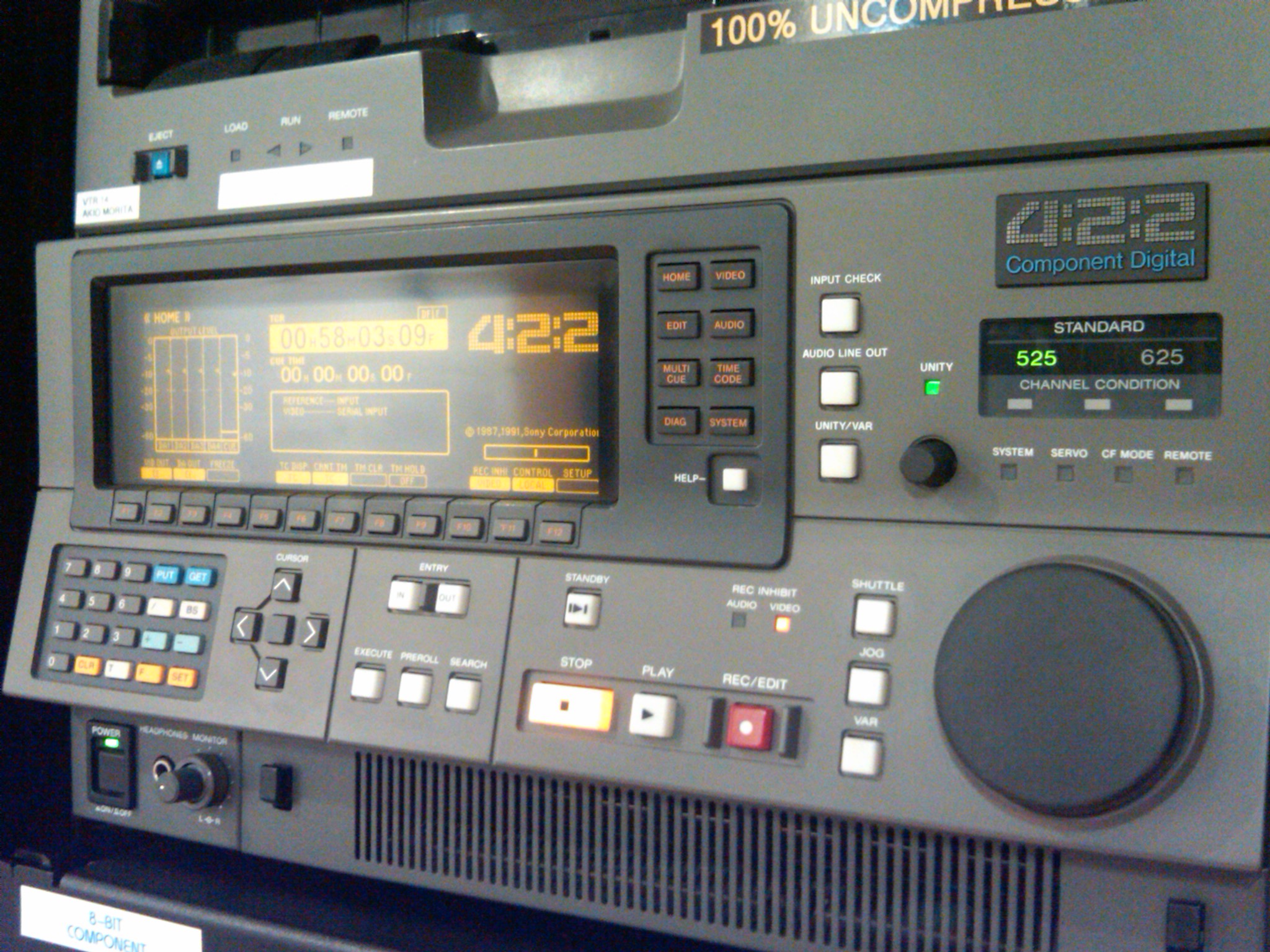|
D2 (video Format)
D-2 is a professional digital videocassette format created by Ampex and introduced in 1988 at the NAB Show as a composite video alternative to the component video D-1 format. It garnered Ampex a technical Emmy in 1989. Like D-1, D-2 stores uncompressed digital video on a tape cassette; however, it stores a composite video signal, rather than component video as with D-1. While component video is superior for advanced editing, especially when chroma key effects are used, composite video was more compatible with most analog facilities existing at the time. History Ampex created the first D-2 video machine, the ACR-225 commercial spot player working with Sony, who had done some early research into composite digital video, as a cost-effective solution for TV broadcasters with large investments in composite analog infrastructure such as video routers and switchers, since it could be inserted into existing analog broadcast facilities without extensive redesign or modifications. This ... [...More Info...] [...Related Items...] OR: [Wikipedia] [Google] [Baidu] |
Magnetic Tape
Magnetic tape is a medium for magnetic storage made of a thin, magnetizable coating on a long, narrow strip of plastic film. It was developed in Germany in 1928, based on the earlier magnetic wire recording from Denmark. Devices that use magnetic tape could with relative ease record and playback audio, visual, and binary computer data. Magnetic tape revolutionized sound recording and reproduction and broadcasting. It allowed radio, which had always been broadcast live, to be recorded for later or repeated airing. Since the early 1950s, magnetic tape has been used with computers to store large quantities of data and is still used for backup purposes. Magnetic tape begins to degrade after 10–20 years and therefore is not an ideal medium for long-term archival storage. Durability While good for short-term use, magnetic tape is highly prone to disintegration. Depending on the environment, this process may begin after 10–20 years. Over time, magnetic tape made in the 1 ... [...More Info...] [...Related Items...] OR: [Wikipedia] [Google] [Baidu] |
Video Router
A video router, also known as a video matrix switch or SDI router, is an electronic switch designed to route video signals from multiple input sources such as cameras, VT/DDR, computers and DVD players, to one or more display devices, such as monitors, projectors, and TVs. Inputs and outputs The number of inputs and outputs varies dramatically. Routers are normally described by ''number of inputs by number of outputs'' e.g. 2x1, 256x256, 576x1152. Some video routers, by the use of additional drop-in cards, allow the system to be expanded for more inputs or outputs, or to support other formats. Signals The signal format that the router transports can be anything from analogue composite video using PAL and NTSC. Also multi-format routers can route more than one Digital video signal format, Serial Digital Interface (SDI), HD-SDI, component video. Some routers have the ability to internally convert digital to analog and analog to digital. For HD Video, HDMI Matrix ... [...More Info...] [...Related Items...] OR: [Wikipedia] [Google] [Baidu] |
South Park
''South Park'' is an American animated sitcom created by Trey Parker and Matt Stone and developed by Brian Graden for Comedy Central. The series revolves around four boysStan Marsh, Kyle Broflovski, Eric Cartman, and Kenny McCormickand their exploits in and around the titular Colorado town. ''South Park'' became infamous for its profanity and black comedy, dark, surreal humor that satire, satirizes a Subject matter in South Park, wide range of topics toward an adult animation, adult audience. Parker and Stone developed ''South Park'' from two animated short films both titled ''The Spirit of Christmas (short film), The Spirit of Christmas''. The second short became one of the first Internet viral videos, leading to ''South Park''s production. The television pilot, pilot episode was produced using cutout animation; subsequent episodes have since used computer animation recalling the cutout technique. ''South Park'' features a large ensemble cast of recurring characters. Since ... [...More Info...] [...Related Items...] OR: [Wikipedia] [Google] [Baidu] |
Metal Particle Tape
Audio compact cassettes use magnetic tape of three major types which differ in fundamental magnetic properties, the level of bias applied during recording, and the optimal time constant of replay equalization. Specifications of each type were set in 1979 by the International Electrotechnical Commission (IEC). By this time, Type I (IEC I, 'ferric' or 'normal' tapes) included pure gamma ferric oxide formulations, Type II (IEC II, or 'chrome' tapes) included ferricobalt and chromium dioxide formulations, and Type IV (IEC IV, or 'metal' tapes) included metal particle tapes—the best-performing, but also the most expensive. In the 1980s the lines between three types blurred. Panasonic developed evaporated metal tapes that could be made to match any of the three IEC types. Metal particle tapes migrated to Type II and Type I, ferricobalt formulations migrated to Type I. By the end of the decade performance of the best Type I ferricobalt tapes (superferrics) approached that of Type IV ... [...More Info...] [...Related Items...] OR: [Wikipedia] [Google] [Baidu] |
D-1 (Sony)
D-1 or 4:2:2 Component Digital is an SMPTE digital recording video standard, introduced in 1986 through efforts by SMPTE engineering committees. It started as a Sony and Bosch - BTS product and was the first major professional digital video format. SMPTE standardized the format within ITU-R 601 (orig. CCIR-601), also known as Rec. 601, which was derived from SMPTE 125M and EBU 3246-E standards. Format D-1 or 4:2:2 D-1 (1986) was a major feat in real time, broadcast quality digital video recording. It stores uncompressed digitized component video, encoded at Y'CbCr 4:2:2 using the CCIR 601 raster format with 8 bits, along with PCM audio tracks as well as timecode on a 3/4 inch (19 mm) videocassette tape (though not to be confused with the ubiquitous 3/4-inch U-Matic/U-Matic SP cassette). The uncompressed component video used enormous bandwidth for its time: 173 Mbit/sec (bit rate). The maximum record time on a D-1 tape is 94 minutes. Because of the uncompromisi ... [...More Info...] [...Related Items...] OR: [Wikipedia] [Google] [Baidu] |
Television Advertisement
A television advertisement (also called a television commercial, TV commercial, commercial, spot, television spot, TV spot, advert, television advert, TV advert, television ad, TV ad or simply an ad) is a span of television programming produced and paid for by an organization. It conveys a message promoting, and aiming to market, a product, service or idea. Advertisers and marketers may refer to television commercials as TVCs. Advertising revenue provides a significant portion of the funding for most privately-owned television networks. During the 2010s, the number of commercials has grown steadily, though the length of each commercial has diminished. Advertisements of this type have promoted a wide variety of goods, services, and ideas ever since the early days of the history of television. The viewership of television programming, as measured by companies such as Nielsen Media Research in the United States, or BARB in the UK, is often used as a metric for television adver ... [...More Info...] [...Related Items...] OR: [Wikipedia] [Google] [Baidu] |
Videocassette
Videotape is magnetic tape used for storing video and usually sound in addition. Information stored can be in the form of either an analog or digital signal. Videotape is used in both video tape recorders (VTRs) and, more commonly, videocassette recorders (VCRs) and camcorders. Videotapes have also been used for storing scientific or medical data, such as the data produced by an electrocardiogram. Because video signals have a very high bandwidth, and stationary heads would require extremely high tape speeds, in most cases, a helical-scan video head rotates against the moving tape to record the data in two dimensions. Tape is a linear method of storing information and thus imposes delays to access a portion of the tape that is not already against the heads. The early 2000s saw the introduction and rise to prominence of high-quality random-access video recording media such as hard disks and flash memory. Since then, videotape has been increasingly relegated to archival and ... [...More Info...] [...Related Items...] OR: [Wikipedia] [Google] [Baidu] |
XLR Connector
The XLR connector is a type of electrical connector primarily used in professional audio, video, and stage lighting equipment. XLR connectors are cylindical in design, and have three to seven connector pins, and are often employed for analog balanced audio interconnections, AES3 digital audio, portable intercom, DMX512 lighting control, and for low-voltage power supply. XLR connectors are included to the international standard for dimensions, IEC 61076-2-103. The XLR connector is superficially similar to the smaller DIN connector, with which it is physically incompatible. History and manufacturers The XLR connector (also Cannon plug and Cannon connector) was invented by James H. Cannon, founder of the Cannon Electric company, Los Angeles, California. The XLR connector originated from the ''Cannon X'' series of connectors in 1915; by 1950, a latching mechanism was added to the connector, which produced the ''Cannon XL'' model of connector, and by 1955, the female conne ... [...More Info...] [...Related Items...] OR: [Wikipedia] [Google] [Baidu] |
AES3
AES3 is a standard for the exchange of digital audio signals between professional audio devices. An AES3 signal can carry two channels of pulse-code-modulated digital audio over several transmission media including balanced lines, unbalanced lines, and optical fiber. AES3 was jointly developed by the Audio Engineering Society (AES) and the European Broadcasting Union (EBU) and so is also known as AES/EBU. The standard was first published in 1985 and was revised in 1992 and 2003. AES3 has been incorporated into the International Electrotechnical Commission's standard IEC 60958, and is available in a consumer-grade variant known as S/PDIF. History and development The development of standards for digital audio interconnect for both professional and domestic audio equipment, began in the late 1970s in a joint effort between the Audio Engineering Society and the European Broadcasting Union, and culminated in the publishing of AES3 in 1985. The AES3 standard has been revised in ... [...More Info...] [...Related Items...] OR: [Wikipedia] [Google] [Baidu] |
Timecode
A timecode (alternatively, time code) is a sequence of numeric codes generated at regular intervals by a timing synchronization system. Timecode is used in video production, show control and other applications which require temporal coordination or logging of recording or actions. Video and film In video production and filmmaking, SMPTE timecode is used extensively for synchronization, and for logging and identifying material in recorded media. During filmmaking or video production shoot, the camera assistant will typically log the start and end timecodes of shots, and the data generated will be sent on to the editorial department for use in referencing those shots. This shot-logging process was traditionally done by hand using pen and paper, but is now typically done using shot-logging software running on a laptop computer that is connected to the timecode generator or the camera itself. The SMPTE family of timecodes are almost universally used in film, video and audio pro ... [...More Info...] [...Related Items...] OR: [Wikipedia] [Google] [Baidu] |
Type C Videotape
1–inch Type C (designated Type C by SMPTE) is a professional reel-to-reel analog recording helical scan videotape format co-developed and introduced by Ampex and Sony in 1976. It became the replacement in the professional video and broadcast television industries for the then-incumbent 2–inch quadruplex videotape (2–inch Quad for short) open-reel format. Additionally, it replaced the unsuccessful type A format, also invented by Ampex, and, primarily in mainland Europe, it supplemented the type B format, invented by the Fernseh division of Bosch, but it was replaced by type C format also there. Technical detail Compared to Quad, Type C had a smaller size, comparative ease of operation, and slightly higher video quality. 1–inch Type C is capable of "trick-play" functions such as still, shuttle, and variable-speed playback, including slow motion. 2–inch quadruplex videotape machines lacked these capabilities, due to the segmented manner in whic ... [...More Info...] [...Related Items...] OR: [Wikipedia] [Google] [Baidu] |
Pulse-code Modulation
Pulse-code modulation (PCM) is a method used to digitally represent sampled analog signals. It is the standard form of digital audio in computers, compact discs, digital telephony and other digital audio applications. In a PCM stream, the amplitude of the analog signal is sampled regularly at uniform intervals, and each sample is quantized to the nearest value within a range of digital steps. Linear pulse-code modulation (LPCM) is a specific type of PCM in which the quantization levels are linearly uniform. This is in contrast to PCM encodings in which quantization levels vary as a function of amplitude (as with the A-law algorithm or the μ-law algorithm). Though ''PCM'' is a more general term, it is often used to describe data encoded as LPCM. A PCM stream has two basic properties that determine the stream's fidelity to the original analog signal: the sampling rate, which is the number of times per second that samples are taken; and the bit depth, which determines t ... [...More Info...] [...Related Items...] OR: [Wikipedia] [Google] [Baidu] |










